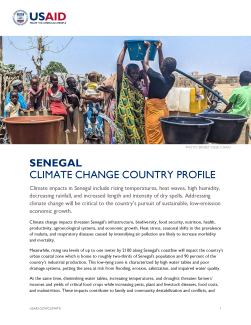Climate impacts in Senegal include rising temperatures, heat waves, high humidity, decreasing rainfall, and increased length and intensity of dry spells. Addressing climate change will be critical to the country’s pursuit of sustainable, low-emission economic growth.
Climate change impacts threaten Senegal’s infrastructure, biodiversity, food security, nutrition, health, productivity, agroecological systems, and economic growth. Heat stress, seasonal shifts in the prevalence of malaria, and respiratory diseases caused by intensifying air pollution are likely to increase morbidity and mortality.
Meanwhile, rising sea levels of up to one meter by 2100 along Senegal’s coastline will impact the country’s urban coastal zone which is home to roughly two-thirds of Senegal’s population and 90 percent of the country’s industrial production. This low-lying zone is characterized by high water tables and poor drainage systems, putting the area at risk from flooding, erosion, salinization, and impaired water quality.
At the same time, diminishing water tables, increasing temperatures, and droughts threaten farmers’ incomes and yields of critical food crops while increasing pests, plant and livestock diseases, food costs, and malnutrition. These impacts contribute to family and community destabilization and conflicts, and accelerate the exodus of populations from rural areas. Climate impacts also have negative implications for the health of fisheries and coastal mangrove ecosystems. Already under stress from overfishing, fisheries are impaired by climate change as rising surface water temperatures and ocean acidification alter species’ reproduction and migration patterns. This, in turn, affects not only biodiversity, but also the livelihoods, incomes, and nutrition of the communities that depend on fishing.
A systems change approach is critical to address climate change impacts in Senegal to 1) scale up integrated water resource management; 2) increase land-use practices that decrease emissions, restore landscapes, and increase adaptability to climate change; and 3) increase the adoption of ecologically sound and socially inclusive and equitable solutions to conserve, manage, and restore forests and other lands to combat climate change while improving livelihoods and resilience.
Government of Senegal’s Climate Priorities
The majority of Senegal’s greenhouse gas emissions come from the agriculture sector, largely driven by livestock production and savanna burning. The extraction of oil and gas reserves is set to start in 2024, and will likely increase domestic fossil fuel consumption. Given Senegal’s high exposure and vulnerability to climate change and in response to the Paris Agreement, Senegal is implementing mitigation and adaptation measures in its infrastructure, and priority economic sectors, ecosystems, rural communities, peri-urban areas, and cities.
In 2022, the Government of Senegal completed sector-specific National Adaptation Plans for infrastructure, agriculture, water resources, coastal zones, livestock, fisheries, and public health. Under the G7’s Just Energy Transition Partnership (JETP), key goals include substantially increasing the share of renewables in the country’s energy portfolio by 2030 and installing infrastructure and technologies that will accelerate the deployment and use of renewable energy. Meanwhile, Senegal’s Nationally Determined Contribution (NDC) calls for reducing carbon dioxide emissions by up to 29.5 percent by 2030, increasing the share of renewable energy in the electricity mix to 40.7 percent by 2035, mobilizing $8.7 billion and $4.3 billion to fund mitigation and adaptation efforts, respectively, and reducing deforestation by 25 percent from 40,000 hectares of land per year to 30,000 hectares of land per year.
The Plan Sénégal Emergent (PSE), the country’s national development strategy, also includes a collection of environmental sustainability and climate projects. The Green PSE Plan is a key tool for Senegal to transition to a more ecologically sensitive economy. Some of the plan’s goals include promoting renewable energy sources like solar and wind and accelerating green and climate-resilient growth by mobilizing green investments in the economy.
USAID’S Climate Change Program: Objectives And Results
USAID expands access to clean energy while improving the resilience of climate-sensitive economic sectors through climate change adaptation measures. USAID programs address overexploitation and agricultural practices that fail to prevent agricultural runoff, conserve soil organic matter, reduce salinization, or achieve other conservation and restoration objectives. Additionally, USAID integrates a holistic approach to address the climate crisis by improving the health of the Senegalese population through expanded malaria interventions, strengthening health data systems, optimizing supply chains, and implementing climate-sensitive policies. Within the broader education system, USAID will consider the integration of climate actions into education and youth workforce development curricula, youth advocacy, the solarization of water services to schools, climate-smart practices in the textbook supply chain, and use of local contexts and national languages in messages and communication strategies. USAID climate actions also support the decentralization process and the transparent allocation and management of natural, mining, and oil and gas resources—along with a better distribution of the revenues those sectors generate in support of the green energy transition.
Adaptation
USAID builds economic resilience in the agriculture and fisheries sectors to help reduce the impacts of climate shocks and stresses in communities while increasing revenues and safeguarding livelihoods. Over the past seven years, USAID and Columbia University’s International Research Institute for Climate and Society assisted Senegal’s National Agency for Civil Aviation and Meteorology to develop, process, and disseminate weather and climate information services (WCIS) to strengthen the resilience of farmers, fishers, and herders to climate change. This effort, which will be sustained over the next five years, calls for increased investment in the WCIS value chain, expanded access to pay-for-service WCIS products, advancements in hydro-meteorological services for flood control and drought management, and improved weather and climate information services for nutrition services and health sector needs. Meanwhile, through Feed the Future, USAID supports smallholders in high-potential horticulture and small-ruminants value chains to uptake climate-smart agriculture technologies and practices and scale up their use of WCIS, including the development of index insurance products, Information and Communications Technology-enabled farmer subscription systems linked to mobile money payment, and contracting models incorporating enhanced climate-risk mitigation through financial mechanisms.
Key Results
USAID has helped:
- Support more than 82,140 people adapt to the effects of climate change in the fisheries sector and the agriculture and horticulture value chains in FY 2023
- Assisted more than 71,240 people in utilizing climate information or implementing risk-reducing actions in the fisheries sector and agriculture and horticulture value chains in FY 2023
Key Adaptation Programs
Scaling Up Investment in Weather and Climate Information Services
These activities will enhance resilience, productivity, and nutritional outcomes in the fishing, farming, and livestock sectors, as well as in pastoralism systems, while expanding the use of products and services to forecast floods, manage droughts, and improve public health in the face of increased climate uncertainty and weather hazards. This will be achieved through scaling up investment in the weather and climate information services value chain.
Senegal Water Resources Management
These activities increase the availability, efficient use, and equitable use of water resources by ensuring water resource governance institutions have access to high-quality data built around transparency and inclusiveness.
Feed the Future Senegal Dooleel Mbay
This activity bolsters agriculture productivity and enhances market access for high-potential value chains while integrating climate considerations from farm to market to equip smallholders with the tools and knowledge needed to more effectively withstand climate shocks.
Feed the Future Nafoore Warsaaji
This activity fosters horticulture value chain linkages and facilitates smallholder engagement in increasingly lucrative business deals with private sector partners, including input suppliers, microfinance institutions, banks, insurance companies, off-takers, and end-market buyers. Risk-transfer mechanisms and solar water pumping lie at the heart of these interventions to reduce energy operating costs for producers, generating adaptation co-benefits and reducing greenhouse gas emissions.
Governance for Local Development Plus
This activity supports local government entities to improve domestic resource mobilization and strengthen service delivery to citizens in key sectors, while promoting the active participation of citizen and civil society representatives in the transparent allocation and management of local resources, which also creates a platform for promoting climate-sensitive budgeting.
Renewable Energy
Through Power Africa, USAID provides technical assistance, transaction advisory services, and support for policy and regulatory frameworks to the Government of Senegal and private sector partners to accelerate on- and off-grid access to renewable energy. USAID supports the development of off-grid solar home systems and mini-grid sectors in Senegal, where more than 55 percent of rural households lack access to electricity. USAID leverages catalytic financing through grants, harnesses new regulation on auto-production of renewable energy (whereby the off-taker pays the renewable energy company to install the equipment), and helps to close bankable projects and decrease operating costs. These investments are lowering diesel dependency and expanding solar services to businesses and enterprises servicing the agriculture, fisheries, and water and sanitation sectors.
Senegal also has a strong track record leveraging its renewable energy sources. In 2023, Senegal signed a JETP agreement with the EU and G7 countries. In the lead-up to this milestone, USAID/Power Africa developed an Energy Transition Strategy for the country, which resulted from an analysis of a set of gas-to-power and clean energy alternatives. The roadmap details several decarbonization recommendations centered on the country’s gas-to-power transition, including innovative approaches to utilize gas infrastructure to develop renewable energy over the long term. Meanwhile, the conversion of existing power plants to natural gas, alongside the construction of new combined-cycle power plants, represents a tool for decarbonization in the short term, with the potential to reduce CO2 emissions by approximately 30 percent. In addition, the Energy Transition Strategy will facilitate the development of renewable energy projects and lower the cost of power generation in the short term while supporting carbon neutrality in the long term.
Key Results
USAID has helped:
- Contribute to the financial close of 803 megawatts (MW) of new generation capacity worth $770 million in investments since 2013; Power Africa partners have also added more than 565 MW of new generation capacity, contributing to more than 815,600 new connections
- Achieve more than 54,800 new connections in Senegal in 2021 through USAID’s Power Africa Off-Grid Project, while leveraging $36 million in private-sector investment
- Support Senegal’s clean energy transition by mobilizing $173 million in investment through USAID’s West Africa Energy Program in 2021, while facilitating 420 MW of additional generation capacity and more than 32,720 new connections
- Provide renewable energy to 8,500 new households through a three-year project with Oolu Solar that ended in 2021, benefiting an estimated 76,500 people and avoiding 484 tons of greenhouse gas emissions.
Key Renewable Energy Programs
Scaling Up Renewable Energy Senegal
This activity unlocks private sector financing to lower operational costs and support the conversion of diesel water-pumping systems and manual water pumps to solar power to lower diesel dependency. The program also helps incentivize private companies to provide solar pumping solutions to smallholders, especially women and youth, in selected off-grid regions. Grants are leveraged to bring bankable processing and irrigation projects to financial close and to pilot solar-powered enterprise hubs and refrigeration-as-a-service models.
The West Africa Trade and Investment Hub
Alongside its co-investment partners and key stakeholders, the West Africa Trade and Investment Hub is at the forefront of implementing climate-smart strategies to fortify climate resilience and mitigation. The mitigation benefits come from installing solar water pumps and avoiding greenhouse gas emissions. Co-investment partners furnish solar water pumps to farmers and vegetable growers across various regions to counter erratic rainfall, resulting in improved irrigation, reduced operating costs as a result of transitioning away from gasoline, and enhanced crop yields.
Natural Climate Solutions
USAID interventions to strengthen marine and coastal management practices and improve their sustainability draw upon biodiversity conservation, ecosystem management, and ecosystem-based adaptation. Activities have focused on the development and implementation of comprehensive sustainable stock management plans for five species, as well as local conventions and adaptation plans that culminated in the creation of a National Adaptation Plan for the fisheries sector. These plans encompass mangrove reforestation, oyster cultivation, and skill development for the youth and women in beekeeping and oyster farming in the estuaries of the Saloum and Casamance rivers.
Meanwhile, Senegal’s Article 6 Strategy identifies potential areas for carbon transactions across sectors and establishes a clear roadmap for implementation, providing an opportunity for the country to strategically manage and expand mangrove and seagrass restoration efforts while leveraging blue carbon. With support from the Comprehensive Action for Climate Change Initiative (CACCI), Senegal is also improving its data collection and analytical capabilities related to natural climate solutions, while strengthening its monitoring, reporting, and verification capabilities to implement its NDC. These efforts are key to successfully implementing high-integrity blue and terrestrial carbon projects. CACCI has also provided additional analytical capability to guide implementation, tracking and reporting, which has helped clarify ambitions, improve data and mutual accountability, and inform Senegal’s NDC and National Adaptation Plans targets.
For More Information




